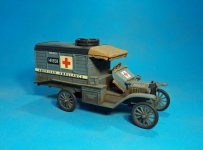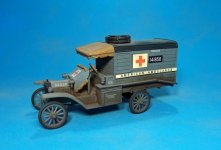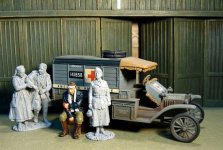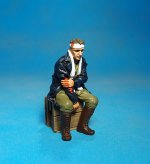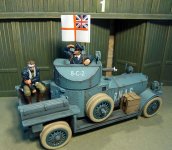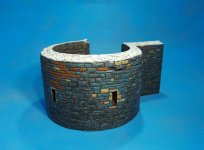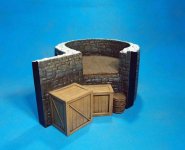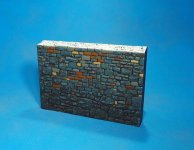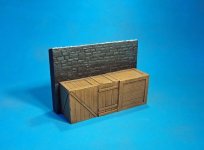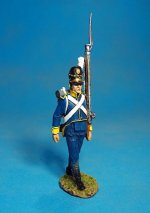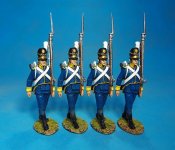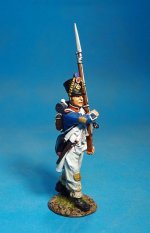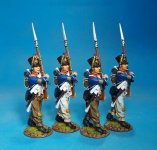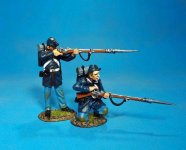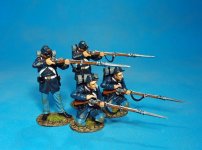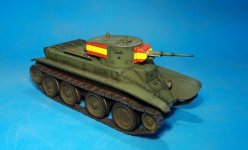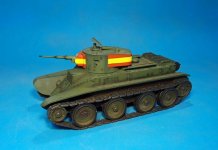Good Morning and welcome to the April new releases from John Jenkins, written on what will be a very warm day here in the Bay area.
We have a bumper crop of releases this month and I think we have something for everyone to enjoy. With figures from Napoleonic Wars, American Civil War Marines, a superb set from Knight of the Skies and lots more. Must be Christmas in April.
As always hope you enjoy these new releases as much as I do. Lots of images to come.
Best regards
Mike
Sierra Toy Soldier Company.
THE GREAT WAR 1914-1918
The Medium Mark C Hornet was a British tank developed during the First World War, but produced too late to see any fighting.
In 1917 Sir William Tritton had developed the Medium Mark A Whippet without involving his former co-worker Walter Gordon Wilson. In response Major Wilson began to design an improved type on his own, the Medium Mark B, in July 1917. As soon as he became aware of Wilson's intentions, Tritton ordered his chief designer, William Rigby, to design a rivaling type: the Medium Mark C. The drawings were approved by the British Army on 19 April 1918. The prototype was finished in August, a few weeks before the Medium B prototype also in construction at Tritton's own factory. At first 200 tanks were ordered; later this was increased to 600, all to be produced by William Foster & Co Ltd at Lincoln with Armlet & Wortley as subcontractor. The colloquial name of the tank was to be "Hornet".It had the general rhomboid shape of the Mark I and later heavy tanks combined with a fixed armoured structure, or Casemate, well forward, fitted with ball-mounts for five machine guns. However, Tritton's Medium Mark C was a much longer vehicle. It had a separate engine compartment at the back like the Medium B, but here it was large enough to house a normal 6-cylinder Ricardo engine behind a standard epicyclic transmission. Also it was easily accessible from the fighting compartment. The larger engine meant the tank had better speed (about 8 mph (13 km/h)). The greater length gave it a superior trench crossing ability. A fuel tank holding 150 imp gal (680 l) of petrol allowed for a range of 140 mi (230 km). Overall mobility therefore was much better.Rigby had taken great care to improve the design's ergonomics. The commander had a special revolving lookout turret and even a small map table. There were eleven vision slits. Special stowage boxes were fitted for the personal gear of the crew of four. Speaking-tubes were used to improve communication. The driver had an odometer.
GWB-03 BRITISH MEDIUM TANK, MARK C, “HORNET”
(2pcs)
Retail us$188
MODEL SIZE 1/30 scale
10 1/2” x 5” x 3 3/4”
MODEL WEIGHT 1,350g
KNIGHTS OF THE SKIES
ALLIED GROUNDCREW AND ACCESSORIES
It was the most common ambulance used by the Allies during the war. Many American field service and Red Cross volunteer drivers drove Model "T" ambulances, including writer Ernest Hemingway and future cartoonist Walt Disney.
It proved to be a very good ambulance. It’s light weight made it well-suited for use on the muddy and shell-torn roads in forward combat areas; and if it got stuck in a hole, a group of soldiers could haul it out without much ado. It was also, as stated, very easy to maintain and repair, and it could take a lot of punishment. By November 1918, 4.362 Model "T" ambulances had been shipped overseas.
The ambulance could carry three patients in litters or four patients seated, and two more could always sit up front with the driver. Canvas "pockets" covered the litter handles, which stuck out at the rear, beyond the tailgate.
BGC-04 U.S. Ford T Ambulance 1918
(1pc)
Retail us$148
This model is a re-paint of the first Ambulance released in 2011, BGC-01.
Future figures will include nurses, medics and a woman Volunteer Ambulance Driver.
BGC-09 WOUNDED PILOT,
(2pcs)
Retail us$39
BGC-09 is also designed to fit with BGC-03 Rolls Royce Armoured Car
THE SEVEN YEARS WAR
LEUT-10A LEUTHEN CHURCHYARD, CORNER TURRET,
(1pc)
Retail us$76
Model Size 7 1/2” x 5 1/2” x 3 1/2”
LEUT-10b STRAIGHT WALL,
(1pc)
Retail us$35
Model Size 5” x 2” x 3 1/2”
THE PENINSULAR WAR 1807-1814
Portugal were Britain’s oldest allies, and no Peninsular war series would be complete without a Portuguese Regiment. Most historians define “Wellington’s Army” as a British force, but usually one third to a half were actually Portuguese.
The 21st Regiment played a part in most of the major battles of the Peninsular War, and was originally raised in Valenza in February 1664. The facings were yellow with yellow collars and cuffs as well as yellow piping and turnbacks.
Portuguese infantry Regiments normally consisted of two battalions. The exception being the 21st which consisted of only the one battalion. The Portuguese battalions were made up of 5 centre companies , a grenadier and a light company. The normal strength was 770 which included all ranks.
PORT-05 PORTUGUESE LINE INFANTRY, 21st LINE INFANTRY REGIMENT, MARCHING LINE INFANTRY
(1pc)
Retail us$40
PORT-05N PORTUGUESE LINE INFANTRY, 21st LINE INFANTRY REGIMENT, MARCHING LINE INFANTRY BOX SET
Retail us$136
PFL-06W FRENCH LINE INFANTRY 1807, 66th Line, 4th Company, FUSILIER MARCHING #1W
(1pc)
Retail us$40
PFL-06B FRENCH LINE INFANTRY 1807, 66th Line, 4th Company, FUSILIER MARCHING #1B
(1pc)
Retail us$40
PFL-06N FRENCH LINE INFANTRY 1807, 66th Line, 4th Company, FUSILIER MARCHING BOX SET #2
Retail us$136
THE AMERICAN CIVIL WAR 1861-1865
ACWM-03 U.S. MARINES 1861-1865, 2 Figures Loading and Firing#1,
(2pcs)
Retail us$68
ACWM-03N U.S. MARINES 1861-1865, 4 Figures Loading and Firing, Box Set #1,
(4pcs)
Retail us$128
THE SPANISH CIVIL WAR
The BT tanks were a series of Soviet cavalry tanks produced in large numbers between 1932 and 1941. They were lightly armoured, but reasonably well-armed for their time, and had the best mobility of all contemporary tanks of the world. The BT tanks were known by the nickname Betka .
They first saw action in the Spanish Civil War. A battalion of BT-5s fought on the Republican side, and their 45 mm guns could easily knock out the opposing German and Italian light tanks.
The BT tanks were "convertible tanks". This was a feature designed by J. Walter Christie to reduce wear of the unreliable tank tracks of the 1930s. In about thirty minutes the crew could remove the tracks and engage a chain drive to the rearmost road wheel on each side, allowing the tank to travel at very high speeds on roads. In wheeled mode the tank was steered by pivoting the front road wheels. However, Soviet tank forces soon found the convertible option of little practical use in a country with few paved roads, and it consumed space and added needless complexity and weight. The feature was dropped from later Soviet designs.
The direct successor of the BT tanks would be the famous T-34 medium tank, introduced in 1940.
NAT-02 NATIONALIST, BT-5, “Fast Tank”,
Retail us$178
SHIPPING NOTES
CC#12 Ltn. BUCHANNON SHIPPING THIS MONTH
CC#14 MORTAR WAGON SHIPPING THIS MONTH
As always hope you like these as much as I do. Now on to the images.
Best regards
Mike
Sierra Toy Soldier Company
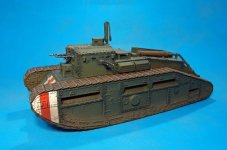
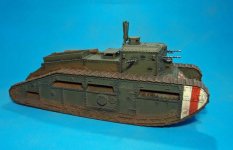
We have a bumper crop of releases this month and I think we have something for everyone to enjoy. With figures from Napoleonic Wars, American Civil War Marines, a superb set from Knight of the Skies and lots more. Must be Christmas in April.
As always hope you enjoy these new releases as much as I do. Lots of images to come.
Best regards
Mike
Sierra Toy Soldier Company.
THE GREAT WAR 1914-1918
The Medium Mark C Hornet was a British tank developed during the First World War, but produced too late to see any fighting.
In 1917 Sir William Tritton had developed the Medium Mark A Whippet without involving his former co-worker Walter Gordon Wilson. In response Major Wilson began to design an improved type on his own, the Medium Mark B, in July 1917. As soon as he became aware of Wilson's intentions, Tritton ordered his chief designer, William Rigby, to design a rivaling type: the Medium Mark C. The drawings were approved by the British Army on 19 April 1918. The prototype was finished in August, a few weeks before the Medium B prototype also in construction at Tritton's own factory. At first 200 tanks were ordered; later this was increased to 600, all to be produced by William Foster & Co Ltd at Lincoln with Armlet & Wortley as subcontractor. The colloquial name of the tank was to be "Hornet".It had the general rhomboid shape of the Mark I and later heavy tanks combined with a fixed armoured structure, or Casemate, well forward, fitted with ball-mounts for five machine guns. However, Tritton's Medium Mark C was a much longer vehicle. It had a separate engine compartment at the back like the Medium B, but here it was large enough to house a normal 6-cylinder Ricardo engine behind a standard epicyclic transmission. Also it was easily accessible from the fighting compartment. The larger engine meant the tank had better speed (about 8 mph (13 km/h)). The greater length gave it a superior trench crossing ability. A fuel tank holding 150 imp gal (680 l) of petrol allowed for a range of 140 mi (230 km). Overall mobility therefore was much better.Rigby had taken great care to improve the design's ergonomics. The commander had a special revolving lookout turret and even a small map table. There were eleven vision slits. Special stowage boxes were fitted for the personal gear of the crew of four. Speaking-tubes were used to improve communication. The driver had an odometer.
GWB-03 BRITISH MEDIUM TANK, MARK C, “HORNET”
(2pcs)
Retail us$188
MODEL SIZE 1/30 scale
10 1/2” x 5” x 3 3/4”
MODEL WEIGHT 1,350g
KNIGHTS OF THE SKIES
ALLIED GROUNDCREW AND ACCESSORIES
It was the most common ambulance used by the Allies during the war. Many American field service and Red Cross volunteer drivers drove Model "T" ambulances, including writer Ernest Hemingway and future cartoonist Walt Disney.
It proved to be a very good ambulance. It’s light weight made it well-suited for use on the muddy and shell-torn roads in forward combat areas; and if it got stuck in a hole, a group of soldiers could haul it out without much ado. It was also, as stated, very easy to maintain and repair, and it could take a lot of punishment. By November 1918, 4.362 Model "T" ambulances had been shipped overseas.
The ambulance could carry three patients in litters or four patients seated, and two more could always sit up front with the driver. Canvas "pockets" covered the litter handles, which stuck out at the rear, beyond the tailgate.
BGC-04 U.S. Ford T Ambulance 1918
(1pc)
Retail us$148
This model is a re-paint of the first Ambulance released in 2011, BGC-01.
Future figures will include nurses, medics and a woman Volunteer Ambulance Driver.
BGC-09 WOUNDED PILOT,
(2pcs)
Retail us$39
BGC-09 is also designed to fit with BGC-03 Rolls Royce Armoured Car
THE SEVEN YEARS WAR
LEUT-10A LEUTHEN CHURCHYARD, CORNER TURRET,
(1pc)
Retail us$76
Model Size 7 1/2” x 5 1/2” x 3 1/2”
LEUT-10b STRAIGHT WALL,
(1pc)
Retail us$35
Model Size 5” x 2” x 3 1/2”
THE PENINSULAR WAR 1807-1814
Portugal were Britain’s oldest allies, and no Peninsular war series would be complete without a Portuguese Regiment. Most historians define “Wellington’s Army” as a British force, but usually one third to a half were actually Portuguese.
The 21st Regiment played a part in most of the major battles of the Peninsular War, and was originally raised in Valenza in February 1664. The facings were yellow with yellow collars and cuffs as well as yellow piping and turnbacks.
Portuguese infantry Regiments normally consisted of two battalions. The exception being the 21st which consisted of only the one battalion. The Portuguese battalions were made up of 5 centre companies , a grenadier and a light company. The normal strength was 770 which included all ranks.
PORT-05 PORTUGUESE LINE INFANTRY, 21st LINE INFANTRY REGIMENT, MARCHING LINE INFANTRY
(1pc)
Retail us$40
PORT-05N PORTUGUESE LINE INFANTRY, 21st LINE INFANTRY REGIMENT, MARCHING LINE INFANTRY BOX SET
Retail us$136
PFL-06W FRENCH LINE INFANTRY 1807, 66th Line, 4th Company, FUSILIER MARCHING #1W
(1pc)
Retail us$40
PFL-06B FRENCH LINE INFANTRY 1807, 66th Line, 4th Company, FUSILIER MARCHING #1B
(1pc)
Retail us$40
PFL-06N FRENCH LINE INFANTRY 1807, 66th Line, 4th Company, FUSILIER MARCHING BOX SET #2
Retail us$136
THE AMERICAN CIVIL WAR 1861-1865
ACWM-03 U.S. MARINES 1861-1865, 2 Figures Loading and Firing#1,
(2pcs)
Retail us$68
ACWM-03N U.S. MARINES 1861-1865, 4 Figures Loading and Firing, Box Set #1,
(4pcs)
Retail us$128
THE SPANISH CIVIL WAR
The BT tanks were a series of Soviet cavalry tanks produced in large numbers between 1932 and 1941. They were lightly armoured, but reasonably well-armed for their time, and had the best mobility of all contemporary tanks of the world. The BT tanks were known by the nickname Betka .
They first saw action in the Spanish Civil War. A battalion of BT-5s fought on the Republican side, and their 45 mm guns could easily knock out the opposing German and Italian light tanks.
The BT tanks were "convertible tanks". This was a feature designed by J. Walter Christie to reduce wear of the unreliable tank tracks of the 1930s. In about thirty minutes the crew could remove the tracks and engage a chain drive to the rearmost road wheel on each side, allowing the tank to travel at very high speeds on roads. In wheeled mode the tank was steered by pivoting the front road wheels. However, Soviet tank forces soon found the convertible option of little practical use in a country with few paved roads, and it consumed space and added needless complexity and weight. The feature was dropped from later Soviet designs.
The direct successor of the BT tanks would be the famous T-34 medium tank, introduced in 1940.
NAT-02 NATIONALIST, BT-5, “Fast Tank”,
Retail us$178
SHIPPING NOTES
CC#12 Ltn. BUCHANNON SHIPPING THIS MONTH
CC#14 MORTAR WAGON SHIPPING THIS MONTH
As always hope you like these as much as I do. Now on to the images.
Best regards
Mike
Sierra Toy Soldier Company


Last edited:


